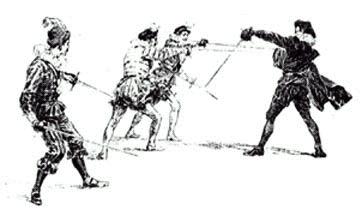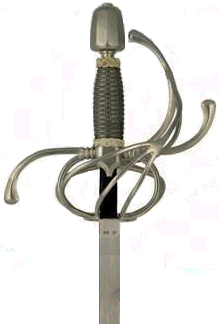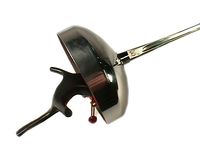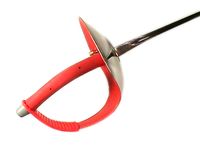
Fencing is an ancient and noble sport. For many hundreds of years, proficiency with the sword was considered one of the essential skills of a well-educated individual, and the sword worn at the side was the hallmark of a gentleman. From its practical origins, when matters of honour and politics were settled with the sword, fencing has evolved into one of the most intense and challenging of modern sports which, is every bit as exciting and demanding as the fencing duel that preceded it.
The Fencing Swords

Rapier
The rapier originated from Spain in the late 15th. Century, but mastered by the Italians. The rapier is not an easy weapon to define as the sword went through many changes over the years. In general the rapier is a relatively thin blade and mainly used as a thrusting weapon with a sharp edge to prevent the opponent from grabbing hold of the sword. The blades run from ¾" to 11/4" in width, 3/32" to ¼" thickness and ranging from 40" to 60" in length. There are many different types of guards from the fancy swept-hilts, to the cup-hilts rapiers.
No other sword or style of swordsmanship is as romanticized as is the rapier from Shakespeare's plays to the three Musketeers and James Bond films and so on. The rapier has long been associated with swashbuckling elegance and rugged excitement.

Foil
The foil, the training sword for the rapier and court sword, has a flexible rectangular blade, approximately 35 inches in length, weighing less than one pound. Points are scored with the tip of the blade. The valid target area in foil is the torso, from the shoulder to the groin, front and back. It does not include the arms, neck, head and legs. The foil fencer's uniform includes a metallic vest (called a lamé), which covers the valid target area, so that a valid hit will register on the scoring machine (electric box). A small, spring-loaded tip is attached to the point of the foil and is connected to a wire inside the blade. The fencer wears a body wire inside his uniform, which connects the foil to a reel wire, connected to the electric box. There are two scoring lights on the machine. One shows a green light when a fencer is hit, and one shows a red light when the opponent is hit. A hit landing outside the valid target area (that which is not covered by the lamé) is indicated by a white light. These "off target" hits do not count in the scoring, but they do stop the fencing action temporarily.

Épée
The épée (pronounced "EPP-pay"), the descendent of the 19th. Century duelling sword, is similar in length to the foil, but is heavier, weighing approximately 27 ounces, with a larger guard (to protect the hand from a valid hit) and a much stiffer blade. Hits are scored only with the point of the blade. The entire body is the valid target area. The épée is also an electrical weapon. The blade is wired with a spring-loaded tip at the end that completes an electrical circuit when it is depressed beyond a pressure of 750 grams. This causes the coloured bulb on the electric box to light. Because the entire body is a valid target area, the épée fencer's uniform does not include a lamé. Off-target hits do not register on the machine.

Sabre
The sabre is the modern version of the cavalry sword, and is similar in length and weight to the foil. The major difference is that the sabre is a cut and thrusting weapon. The target area is from the bend of the hips (both front and back), to the top of the head, simulating the cavalry rider on a horse. The sabre fencer's uniform includes a metallic jacket (lamé), which covers the target area to register a valid hit on the electric box. The mask is different from foil and epee, with a metallic covering since the head is a valid target area. Just as in foil, there are two scoring lights on the machine. One shows a green light when a fencer is hit, and one shows a red light when the opponent is hit. Off-target hits do not register on the machine.
The Right-Of-Way
One of the most difficult concepts to visualize in foil and sabre fencing is the rule of "right-of-way". This rule was established to eliminate simultaneous attacks by two fencers. In essence, right-of-way is the differentiation of offence and defence, made by the referee. The difference is important only when both the red and green lights go on at the same time in foil and sabre. When this happens, the winner of the point is the one who the referee determined was on offence (i.e. has a Straight arm) at the time the lights went on. Épée does not use the right-of-way in keeping with its duelling origin - he who first gains the hit earns the point. Or, if both fencers hit within 1/25th of a second of each other, both earn a point. However, it is equally important to have a sound defence for épée, since the entire body must be protected from a touch.
